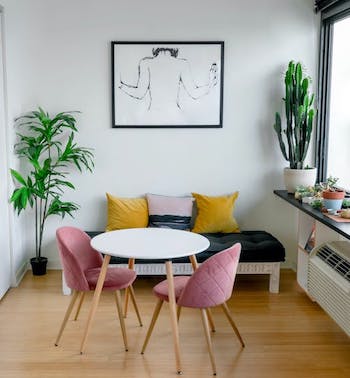Whether you’re hunting for the best bargains, upcycling old furniture, or adding those personal touches that make a house a home, you’ll find valuable insights and practical advice tailored to making your shared living experience as harmonious and comfortable as possible, all while keeping an eye on the budget.
Welcome to your ultimate guide to furnishing on a budget with roommates!

Table of Contents
Importance of Budgeting
Diving into the realm of furnishing a shared space without a solid budget is like navigating a ship without a compass. You might eventually reach your destination, but the journey could be fraught with unnecessary challenges and expenses. Here’s why budgeting is not just important, but essential in the quest for cost-effective furnishing with roommates:
- Avoiding Financial Stress: Furnishing a home should be an exciting adventure, not a source of financial strain. A well-planned budget acts as a safety net, ensuring that you and your roommates enjoy the process without the looming cloud of monetary woes. It prevents impulsive purchases and keeps your financial health in check, ensuring that rent, utility bills, and other expenses don’t get overshadowed by a fancy new sofa or an extravagant decor piece.
- Encouraging Collective Decision Making: When roommates come together with a shared budget, it fosters a sense of collective decision-making. Each person has a stake in the choices made, leading to more democratic and thoughtful purchasing. This collaborative approach not only strengthens the bond between roommates but also ensures that the space reflects the collective personality and preferences of all the occupants.
- Facilitating Smart Purchases: A budget acts as a framework within which you can explore various furnishing options. It encourages you to research, compare prices, and seek out the best deals. This mindful approach to shopping not only saves money but also leads to more satisfying purchases. You’re less likely to experience buyer’s remorse when you know you’ve secured a great deal that aligns with your budgetary constraints.
- Enabling Long-term Planning: Budgeting is not just about the immediate expenses; it’s also about planning for the future. Furniture and decor are not one-time purchases; they are part of your living space that evolves over time. A budget helps you allocate resources wisely, ensuring that you can gradually upgrade or add new pieces without financial upheaval. It’s about creating a sustainable lifestyle where changes and improvements to your living space are made with foresight and financial prudence.
- Inspiring Creativity: Interestingly, having a budget can actually boost creativity. It pushes you to think outside the box and explore DIY options, thrift stores, and upcycling opportunities. The constraints of a budget can lead you to discover unique, cost-effective ways to personalize your space, turning the furnishing process into a fun, creative endeavor.
In essence, budgeting is the cornerstone of a harmonious, stress-free furnishing experience. It’s about making informed choices, fostering unity among roommates, and transforming a house into a home, all while ensuring that your financial well-being is preserved. So, before you set out on your furnishing journey, take a moment to set a budget—it’s a small step that makes a big difference!
Different Types of Furnishings
Embarking on the journey of furnishing a shared space brings to light the myriad of options available. Understanding the different types of furnishings is like having a roadmap for this adventure, guiding you through choices that align with your budget, style, and functional needs. Let’s explore the landscape of furnishings, focusing on the contrasts between new and second-hand items, each with its own set of pros and cons.
New vs. Second-Hand
- New Furnishings:
- Pros:
- Pristine Condition: New furniture comes without a history, offering fresh, untouched quality and undisputed ownership.
- Warranty and Guarantees: These items often come with warranties or guarantees, ensuring peace of mind and protection against manufacturing defects.
- Latest Trends: Staying current is effortless with new furniture, as it often reflects the latest styles, materials, and technological advancements.
- Customization: Many retailers offer options to customize your furniture, allowing you to select colors, fabrics, and finishes that resonate with your personal style.
- Cons:
- Higher Cost: The most noticeable downside is the price. New furnishings can be a significant investment, potentially straining your budget.
- Depreciation: Just like a new car, new furniture loses value the moment it enters your home, making it a less favorable option if you enjoy changing your decor frequently.
- Environmental Impact: The production, packaging, and transportation of new furniture contribute to carbon emissions, making it a less eco-friendly choice.
- Pros:
- Second-Hand Furnishings:
- Pros:
- Cost-Effectiveness: Pre-loved furniture is kinder to your wallet, offering functional and aesthetic value without the hefty price tag of new items.
- Unique Finds: Second-hand shopping can uncover unique, vintage pieces that add character and a story to your space, setting it apart from the mainstream.
- Eco-Friendly: Opting for used furniture is a green choice. It reduces waste, minimizes demand for new production, and contributes to a more sustainable lifestyle.
- Potential for Upcycling: Second-hand items can be transformed through DIY projects, allowing you to infuse personal style and new life into a piece.
- Cons:
- Condition and Cleanliness: Pre-owned furnishings may come with signs of wear or require deep cleaning or repairs, demanding extra time and effort before they’re ready for your space.
- Limited Options: You might not always find what you’re looking for, and matching specific styles or sets can be challenging.
- Lack of Warranty: Used items typically don’t come with warranties or return policies, meaning you assume more risk with your purchase.
- Pros:
When choosing between new and second-hand furnishings, consider your priorities, whether it’s budget constraints, style preferences, or environmental impact. Both options offer distinct benefits, and often, a balanced mix can create a functional, stylish, and personalized living space. Remember, the goal is to craft a home that resonates with the collective spirit of its inhabitants, making the furnishing process not just a task, but a shared journey of creativity and collaboration.
Discussing Budget with Roommates
When you’re sharing your living space, the art of budgeting becomes a collective endeavor, a dance of numbers and compromises that requires harmony and understanding among all roommates. Discussing the budget isn’t merely about agreeing on a figure; it’s about setting the foundation for a living arrangement that respects everyone’s financial comfort and lifestyle preferences. Here’s how to navigate this crucial conversation effectively:
Setting Expectations
- Open Dialogue: Initiate the budget discussion with openness and honesty. Create a comfortable atmosphere where everyone feels safe to express their financial limits and expectations.
- Understand Individual Priorities: Not everyone values the same things. While one roommate might prioritize a high-quality, comfortable couch, another might advocate for investing in a robust entertainment system. Understanding and respecting these priorities is key to a balanced budget that satisfies everyone.
- Set Clear Boundaries: It’s essential to establish what is non-negotiable and where there’s room for flexibility. Knowing these boundaries can prevent future conflicts and ensure a smoother decision-making process.
Allocating Expenses
- Fair Division: The budget should be divided in a way that feels fair to all. This doesn’t necessarily mean equal parts. Take into account individual incomes and agree on a division that everyone is comfortable with.
- Tracking Expenses: Use apps or spreadsheets to track expenses related to furnishing. Transparency in spending helps maintain trust and ensures everyone stays on the same page.
- Plan for Additional Costs: Remember to account for unexpected expenses. A little cushion in the budget can alleviate the stress of unforeseen costs, whether it’s delivery fees, installation charges, or last-minute additions.
- Future Considerations: Discuss how future furnishing decisions will be handled. Life changes, and the living arrangement might evolve. Establishing a protocol for future purchases or replacements can prevent misunderstandings and ensure that the space continues to meet everyone’s needs.
Discussing the budget with your roommates is more than a financial transaction; it’s an investment in your shared living experience. It requires patience, understanding, and a bit of negotiation. But when done right, it paves the way for a harmonious home where not just the furniture, but also the financial responsibilities, are perfectly in place.
Planning the Space
Transforming a house into a home is a creative journey, and when shared with roommates, it becomes a collaborative canvas where each stroke reflects a collective vision. Planning the space is more than deciding where the sofa goes or what color the curtains should be. It’s about creating a cohesive, functional, and personal environment that resonates with everyone living there. Here’s how you can navigate the planning phase effectively:
Discussing Theme and Style
- Collective Mood Board: Start by creating a mood board, either physically or digitally, where everyone can pin ideas, colors, styles, or furniture pieces they like. This visual compilation serves as a starting point for defining the common aesthetic of the shared space.
- Respect Individual Preferences: While some areas like the living room and kitchen are communal, personal spaces like bedrooms can cater to individual tastes. Ensure that communal spaces reflect a blend of everyone’s style, promoting harmony and a sense of belonging.
- Decide on a Theme: Based on the mood board and discussions, decide on a cohesive theme for your space. Whether it’s modern minimalist, bohemian chic, or industrial rustic, having a clear theme ensures that future purchases and decorations align with the collective vision.
Functionality vs. Aesthetics
- Evaluate the Space: Understand the layout and dimensions of your space. Identify which areas are communal and which are personal, and plan accordingly. Consider the flow of movement, natural lighting, and how the space will be used on a daily basis.
- Functional Needs: Discuss and prioritize the functional needs of the space. If your group enjoys movie nights, investing in a comfortable and spacious seating arrangement might take precedence. If cooking is a shared passion, the kitchen might need more focus and budget allocation.
- Aesthetic Appeal: While functionality is crucial, the aesthetic appeal of your space plays a significant role in making it feel like home. Choose color schemes, textures, and decor that elevate the ambiance, making the space not just livable but also enjoyable.
- Flexibility for Changes: Remember, needs and preferences evolve. Plan your space in a way that allows for adjustments and additions in the future. Opt for furniture and arrangements that offer flexibility and can adapt to changing needs or tastes.
Planning the space with your roommates is an exercise in creativity, compromise, and communication. It’s about blending different ideas, respecting individual needs, and coming together to create a shared sanctuary that feels like home to everyone. Remember, the goal is to create a space that not only looks good but also feels right – a space where every furniture piece, every color, and every decor item tells the story of the people who live there.
Where to Shop
When the blueprint of your shared space is ready and the budget is set, the next adventure is shopping for the furnishings. Knowing where to shop can make this journey not just cost-effective, but also enjoyable and rewarding. Whether you prefer the convenience of online stores or the charm of local thrift shops, each option comes with its own set of advantages. Let’s explore the avenues where you can find the perfect pieces to bring your collective vision to life.
Online Stores
- Convenience and Variety: Online stores offer the ultimate convenience of browsing and shopping from the comfort of your home. The vast selection means you’re likely to find something that suits your style, budget, and needs.
- Price Comparisons: One of the biggest advantages of online shopping is the ability to compare prices across different platforms effortlessly. This ensures you get the best deal without having to physically hop from one store to another.
- Customer Reviews: Online reviews can be a valuable resource. They provide insights into the quality, durability, and actual appearance of the furniture, helping you make more informed decisions.
- Delivery Options: Most online stores offer delivery services, some even with the option of setting up the furniture for you. This can be particularly convenient when dealing with large or bulky items.
Local Thrift Shops
- Unique Finds: Thrift shops are treasure troves of unique, vintage pieces. If you’re looking for furniture with character and history, these shops should be your go-to.
- Eco-Friendly Shopping: Buying second-hand is a green choice. It’s a way to recycle and repurpose furniture, reducing the demand for new production and contributing to a more sustainable environment.
- Support Local Businesses: Shopping at local thrift shops helps support local economies and small businesses, which often put back a significant portion of their earnings into the community.
- The Joy of the Hunt: For some, the thrill of finding that perfect piece in a thrift shop adds an extra layer of satisfaction to the shopping experience. It’s not just shopping; it’s an adventure.
Whether you choose the convenience and variety of online stores or the charm and uniqueness of local thrift shops, remember that the goal is to find pieces that resonate with your collective vision and fit within your budget. Each shopping avenue offers a unique experience and brings different benefits to the table. So, why not mix and match? Combining the efficiency of online shopping with the thrill of thrift store hunts can lead to a well-furnished space that’s both stylish and smart on the budget. Happy hunting!
Tips for Bargain Hunting
Furnishing a space with roommates on a budget can be a thrilling quest for quality and style without breaking the bank. Becoming a savvy bargain hunter is about more than just finding the lowest price; it’s about securing the best value for your money. Here are some invaluable tips to help you and your roommates become adept at sniffing out those unbeatable deals and transforming your shared space into a haven of style and comfort, all while maintaining a healthy budget.
Seasonal Sales
- Know the Sale Seasons: Retailers often have sales during specific times of the year, like post-holiday sales, back-to-school periods, or during Black Friday. Timing your purchases around these periods can lead to significant savings.
- Subscribe to Newsletters: Many stores send out exclusive deals and early sale notifications to their subscribers. Signing up for newsletters from your favorite furniture stores can give you a head start on great deals.
Negotiation Strategies
- Ask for Discounts: Don’t hesitate to ask for a discount, especially when buying in bulk or purchasing a big-ticket item. Even if it’s just a small percentage off, it can make a big difference.
- Haggle with Grace: In places where haggling is acceptable, like flea markets or garage sales, it’s an art worth mastering. Always be polite, know the value of the item, and be willing to walk away if the price doesn’t feel right.
Utilize Cashback and Reward Programs
- Credit Card Rewards: If you have a credit card that offers cashback or rewards for purchases, use it to your advantage. Just be sure to pay off the balance in full to avoid interest charges.
- Loyalty Programs: Many stores have loyalty programs that offer points, discounts, or other perks. Joining these programs can provide long-term savings and benefits.
Explore Multiple Venues
- Compare Prices: Before making a purchase, compare prices across different platforms. Sometimes the difference in price for the same item can be substantial.
- Check Out Local Marketplaces: Online marketplaces like Craigslist or Facebook Marketplace can be gold mines for furniture deals. People moving out often sell good quality items at a fraction of the original price.
Inspect and Invest Wisely
- Check for Quality: When buying second-hand or discounted items, inspect them thoroughly for quality. Investing in a piece that’s durable and timeless, even if it’s slightly more expensive, can be more cost-effective in the long run.
- Think Long-Term: Consider the longevity and versatility of the furniture. Choosing pieces that are durable and can adapt to different settings can save you money and hassle in the future.
Bargain hunting is more than a skill—it’s an adventure in frugality and smart shopping. By combining patience, research, and a bit of negotiation, you and your roommates can fill your shared space with treasures that tell a story of savvy shopping and collective creativity. Happy hunting!
Upcycling Old Furniture
In the journey of furnishing a home, upcycling old furniture stands out as an eco-friendly, creative, and budget-conscious choice. It’s about seeing beyond the surface wear and tear, recognizing the potential, and breathing new life into pieces that others might overlook. Whether it’s a chair needing a new coat of paint, a table awaiting transformation, or a shelf needing a bit of creativity, upcycling is your chance to infuse personality and style into your space while being kind to the planet and your wallet. Here’s how you and your roommates can master the art of upcycling:
Step-by-Step Guide
- Choose the Right Piece: Look for furniture that’s structurally sound and has potential for transformation. Flea markets, garage sales, and online marketplaces are treasure troves for such finds.
- Envision the End Result: Before you start, have a clear vision of what you want the piece to look like. Consider how it will fit into your space and what function it will serve.
- Gather Your Materials: Depending on your project, you may need paint, sandpaper, new hardware, fabric, or other materials. Make sure you have everything you need before you begin.
- Prep the Piece: Clean the furniture thoroughly and make any necessary repairs. Sanding can help remove old paint or finish, providing a clean slate for your creativity.
- Transform: Now, the fun part begins. Paint, upholster, or modify the piece to match your vision. Don’t be afraid to get creative – this is your chance to create something unique.
- Seal and Protect: Once you’re happy with your work, apply a sealant or protective finish. This will help your masterpiece withstand the test of time and everyday use.
Tools and Materials
- Basic Toolkit: Have a basic toolkit on hand, including screwdrivers, a hammer, pliers, and a measuring tape.
- Painting Supplies: If you’re painting, you’ll need brushes or rollers, paint trays, and drop cloths to keep your workspace clean.
- Sanding Equipment: For most upcycling projects, you’ll need sandpaper or a sanding block to smooth out surfaces and remove old finishes.
- Safety Gear: Don’t forget safety goggles, gloves, and masks, especially if you’re working with paint or chemicals.
Upcycling old furniture is more than a project; it’s a statement. It’s about choosing sustainability over disposability, creativity over conformity, and personalization over mass production. Each stroke of paint, each tightened screw, and each chosen fabric is a testament to the power of transformation and the beauty of second chances. So, dive into the world of upcycling, and let your collective creativity shine through each piece you revive. Your home will not only be a space of comfort but also a gallery of stories and a testament to your creativity and care for the environment.
Handmade Decor
Creating handmade decor is an intimate and fulfilling way to infuse your shared living space with warmth, personality, and a sense of collective craftsmanship. It’s about transforming ordinary materials into extraordinary pieces of art that speak volumes about the creativity and bond between roommates. Whether it’s crafting a wall hanging, fashioning a centerpiece, or creating unique lighting fixtures, handmade decor adds a special touch that makes your space uniquely yours. Here’s how you can embark on this creative journey and turn your shared home into a canvas of personal expression.
Simple DIY Projects
- Custom Wall Art: Collaborate on a large canvas or a series of small ones to create a wall art installation. Use paints, fabric scraps, or even recycled materials to craft a piece that reflects your collective aesthetic.
- Decorative Planters: Upcycle old containers or jars into planters. Paint them, add some designs, and plant some greenery. Plants not only bring life to your space but also improve air quality.
- Handcrafted Coasters: Use materials like ceramic tiles, cork, or even slices of wood to create unique coasters. Personalize them with paint, fabric, or decorative elements.
Benefits of Personal Touch
- Uniqueness: Handmade decor ensures that your living space is one-of-a-kind. These items are exclusive to your home, telling stories that mass-produced items simply cannot.
- Cost-Effective: Creating your own decor is often more budget-friendly than purchasing items from high-end stores. It allows you to style your home beautifully without straining your finances.
- Sense of Achievement: There’s a profound sense of satisfaction that comes from making something with your own hands. It’s not just about the finished product, but also about the joy and fulfillment that comes from the creative process.
- Strengthening Bonds: Crafting together can be a bonding experience for roommates. It encourages teamwork, communication, and a shared sense of accomplishment.
Handmade decor goes beyond mere aesthetics; it’s a testament to creativity, a nod to sustainability, and a celebration of personal expression. Each handmade piece in your home is a story, a memory, and a shared accomplishment that adds depth and warmth to your living space. So, gather your materials, set aside some time, and let the creative juices flow. Your home will not just be a living space but a living testament to your creativity and collaboration.
Efficient Space Utilization
In a shared living space, where diverse lifestyles, preferences, and belongings converge, efficient space utilization is not just a desire—it’s a necessity. It’s about creating a harmonious environment where every square foot is optimized, not just for functionality, but also for comfort and aesthetic appeal. This is especially crucial when roommates are involved, as it ensures that everyone’s needs are met without the space feeling cluttered or cramped. Here’s how you can maximize the potential of your shared space through thoughtful and efficient utilization.
Multi-functional Furniture
- Sofa Beds and Daybeds: These are perfect for living rooms or guest rooms, providing a comfortable seating area during the day and transforming into a cozy sleeping space when needed.
- Ottomans with Storage: Ottomans can serve multiple purposes: as a footrest, extra seating, and a storage unit. Choosing those with internal storage helps keep the space tidy and organized.
- Extendable Tables: An extendable dining table can adapt to your needs, providing space for daily use and the option to expand it for gatherings or special occasions.
- Nesting Tables: These tables can be stacked or expanded, offering flexibility and saving space when not in use.
Storage Solutions
- Vertical Storage: Utilize vertical space with tall shelving units, wall-mounted shelves, or hanging organizers. This approach maximizes storage without taking up valuable floor space.
- Under-the-Bed Storage: Utilize the space under beds with storage bins or drawers. It’s an excellent spot for storing out-of-season clothing, extra bedding, or rarely used items.
- Built-in Units: Consider built-in shelves or cabinets, especially in small or awkward spaces. These can provide seamless storage solutions without encroaching on the living area.
- Divide and Conquer: Use bookshelves or decorative screens as room dividers. This can help define different areas within an open space while providing additional storage or display space.
Maintaining a Cohesive Style
- Consistent Color Scheme: Use a consistent color scheme to create a sense of unity and flow in the space. This doesn’t mean everything has to match perfectly, but a cohesive palette can make the space feel more organized and intentional.
- De-clutter Regularly: Regular de-cluttering sessions help keep the space open and breathable. It’s also an opportunity for roommates to reassess their belongings and decide what’s essential.
- Thoughtful Arrangement: Arrange furniture and decor in a way that encourages easy movement and interaction. Ensure there’s enough space around furniture for comfortable navigation.
Efficient space utilization is about making the most of what you have in a way that caters to the functional and aesthetic needs of all roommates. It’s about creating a living environment where every item has a purpose, every nook is thoughtfully utilized, and the entire space harmoniously serves the collective lifestyle of its inhabitants. With a blend of multi-functional furniture, innovative storage solutions, and a cohesive style, your shared home can be transformed into a haven of efficiency, comfort, and personal expression.
Accessorizing on a Budget
Accessorizing your shared space is the final, exciting step in turning a house into a home. It’s about adding those finishing touches that reflect your collective personality and style. However, with roommates and a shared budget, it’s essential to accessorize thoughtfully, ensuring that each item not only adds aesthetic value but also aligns with your financial constraints. Here’s how you can spruce up your space with accessories that are as economical as they are beautiful.
DIY Decor
- Handmade Artwork: Channel your inner artist by creating your own artwork. Use canvases, paint, and your imagination to craft pieces that are uniquely yours. Even simple abstract pieces can add a splash of color and personality to your walls.
- Upcycled Items: Transform everyday items into decor pieces. Old jars can become vases, wine bottles can be turned into candle holders, and a piece of driftwood can be a rustic, natural addition to your space.
- Sewing Projects: If you have basic sewing skills, consider making your own cushions, curtains, or table linens. Choose fabrics that match your color scheme to ensure a cohesive look.
Second-hand Finds
- Thrift Stores and Garage Sales: These are goldmines for budget-friendly decor. You might find vases, artwork, mirrors, and other decorative items at a fraction of the retail price.
- Online Marketplaces: Websites like eBay, Craigslist, or Facebook Marketplace can be great sources for gently used decor items. Be sure to check listings regularly, as the best deals can go quickly.
Nature’s Touch
- Plants: Greenery can bring life and freshness to any space. Opt for low-maintenance indoor plants or even consider starting an herb garden in your kitchen.
- Natural Elements: Incorporate elements like stones, shells, or pinecones into your decor. These can be used in glass bowls, as part of a centerpiece, or simply scattered around to add a natural, earthy feel.
Smart Shopping for New Items
- Discount Stores: Stores like TJ Maxx, Marshalls, or HomeGoods often have high-quality decor at discounted prices. You can find anything from rugs and lamps to decorative bowls and artwork.
- Sales and Clearance Sections: Don’t overlook the sale or clearance sections of your favorite stores. Sometimes, the perfect accessory is just waiting to be discovered at a reduced price.
Accessorizing on a budget is not about compromising on style; it’s about embracing creativity, exploring second-hand options, and making the most of what’s available. With a little ingenuity and a keen eye for deals, you can adorn your shared space with accessories that resonate with your collective tastes and stories, all while keeping your finances comfortably in check.
FAQ
How do we set a budget for furnishing our shared space?
Start by discussing individual financial limits and expectations. Consider all expenses, including rent, utilities, and personal needs. Then, decide on a comfortable amount each roommate can contribute. Track expenses using apps or spreadsheets to maintain transparency.
See Related Posts

How to Evict a Roommate Not on the Lease

What Household Items To Share With Your Roommates

Understanding When Your Living Situation With Roommates No Longer Works

Navigating Roommate Living Without Formal Agreements

What to do if your roommate breaches the roommate agreement?

My Roommates Won’t Clean the Bathroom

What do I need to know before lending my roommate money?

Unspoken Roommate Rules in Indian Hostels: A Comprehensive Guide

Roommate Constantly Talks to Themself


